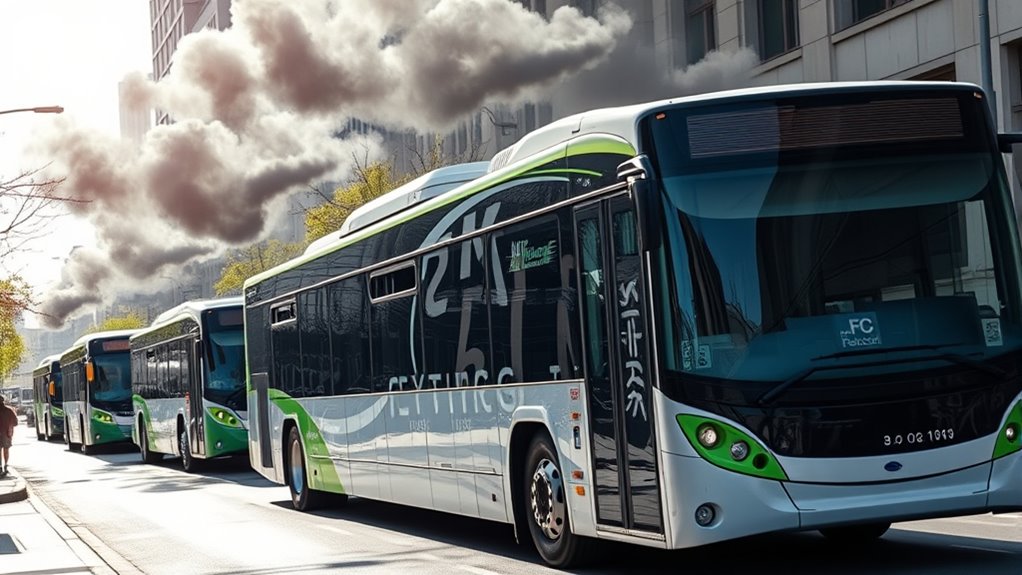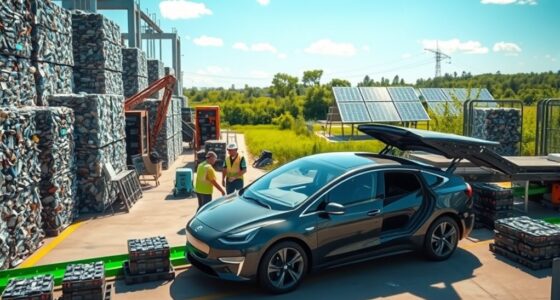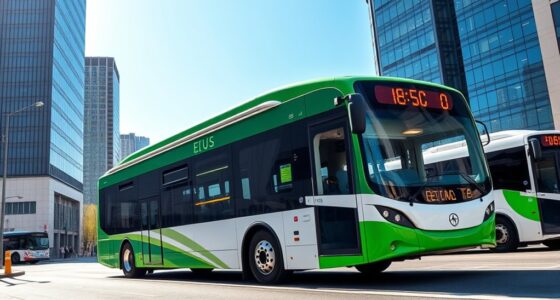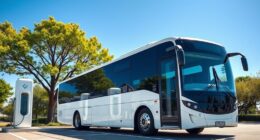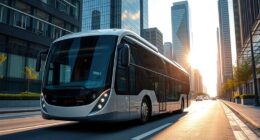Electric buses produce far fewer greenhouse gases and local pollutants than diesel buses, especially when powered by clean energy. They emit no tailpipe emissions and are about 70% more energy efficient. Over their lifetime, their carbon footprint can be reduced by 19–87%, depending on the regional energy mix. As grids become greener, these benefits will only grow. Stay with us to discover how regional factors influence their environmental impact.
Key Takeaways
- Electric buses produce zero tailpipe emissions, significantly reducing local air pollution compared to diesel buses.
- Lifecycle emissions for electric buses are 29–87% lower than diesel and depend on regional energy sources.
- Cleaner grids and renewable energy increase electric buses’ carbon footprint benefits; coal-heavy regions see smaller reductions.
- Electric buses are about 70% more energy efficient than diesel buses, further lowering their overall carbon impact.
- As electricity grids decarbonize, electric buses will achieve even greater reductions in greenhouse gas emissions.
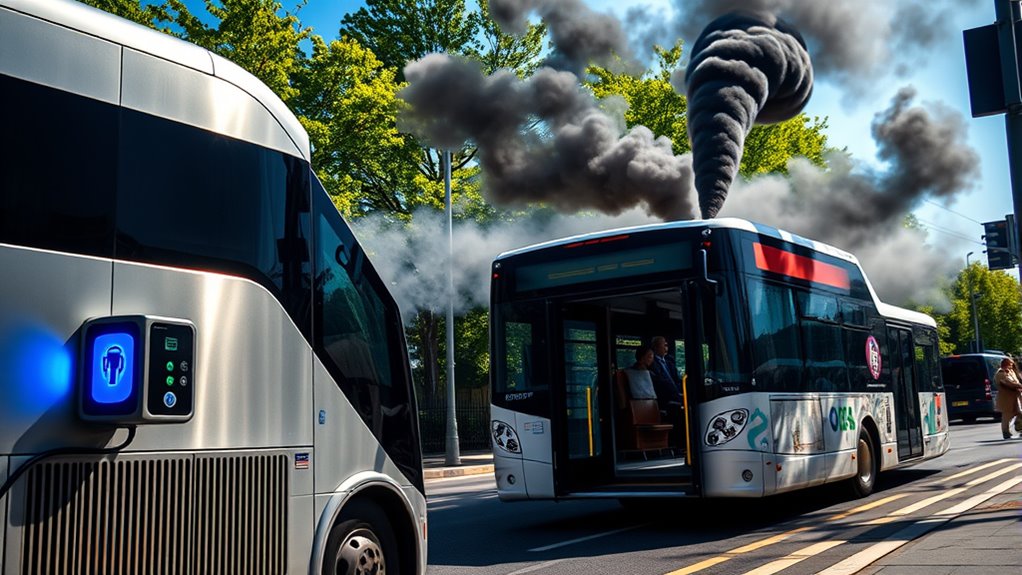
As cities seek cleaner transportation options, electric buses stand out for their considerably lower carbon footprint compared to traditional diesel counterparts. Unlike diesel buses, which emit harmful pollutants like particulate matter and nitrogen oxides directly into the air, electric buses produce zero tailpipe emissions. This means they don’t contribute to local air pollution, improving urban air quality immediately. Passengers and drivers riding electric buses are no longer exposed to exhaust fumes, which reduces health risks associated with respiratory issues and offers a substantial public health benefit.
Electric buses produce zero tailpipe emissions, improving urban air quality and public health by reducing exposure to harmful pollutants.
Looking at their lifecycle emissions, electric buses generally produce 29–87% fewer emissions than diesel buses and 19–85% less than natural gas buses, depending on where you are. In the U.S., for example, electric buses match diesel buses that get about 15 miles per gallon—much better than the actual diesel bus average of around 4.8 mpg. Additionally, advancements in battery technology are continuously reducing manufacturing emissions, making electric buses even more sustainable over time. Moreover, battery manufacturing emissions are offset within one to two years of operation thanks to the energy savings and cleaner grid integration.
In India, where electricity generation varies widely, electric buses still show a 19–96% reduction in lifetime emissions compared to diesel, especially as grids become cleaner. Even in coal-heavy regions, like parts of India, electric buses still cut emissions by roughly 19%. When grids run entirely on renewable energy, electric buses can slash emissions by up to 96% compared to diesel, making them a truly sustainable choice.
Regional differences highlight just how much the benefits depend on local energy sources. In coal-dependent areas of the United States, electric buses still reduce emissions by about 1.4 times compared to diesel, while in regions with abundant renewable energy, they outperform diesel by up to 7.7 times. This variability underscores the importance of integrated energy planning for transportation sustainability.
For example, in North Carolina, electric buses perform similarly to diesel buses getting 15 mpg, and in California, natural gas buses are only about 9% cleaner than diesel, far less impressive than electric options. As grids decarbonize, their advantage will only grow, further shrinking the carbon footprint of electric transit.
Operational efficiency also sets electric buses apart. They’re roughly 70% more energy efficient than diesel buses in real-world use, such as in India. Unlike diesel, which locks in emissions for the lifetime of the vehicle, electric buses’ emissions are heavily influenced by how their electricity is generated. A high efficiency profile makes electric buses more environmentally friendly overall.
While manufacturing batteries does produce some emissions, these are offset within one to two years of operation thanks to the energy savings and cleaner grid integration. Features like regenerative braking further improve efficiency by recapturing energy during stops. This technology not only enhances performance but also contributes to overall emission reductions.
Looking ahead, the continued decarbonization of electricity grids will amplify electric buses’ advantages. Countries aiming to phase out coal and increase renewable energy will see their emissions from electric buses drop even further. Grid decarbonization remains a critical factor in maximizing their climate benefits.
Initiatives like battery recycling and on-site solar power can reduce upstream emissions, making electric buses an even greener choice. However, fleet turnover delays mean that diesel buses purchased today will still emit considerably over their 12- to 15-year lifespan, underscoring the importance of early adoption for meaningful climate impact.
Frequently Asked Questions
How Do Maintenance Costs Compare Between Electric and Diesel Buses?
You’ll find electric buses generally cost less to maintain than diesel buses. They’ve fewer moving parts, leading to lower mechanical wear and tear.
Maintenance costs per mile for electric buses are about $0.64, compared to around $1.53 for diesel buses.
Plus, warranty coverage and fewer unscheduled repairs make electric buses more cost-effective over their lifespan, saving you money on both routine and unexpected maintenance needs.
What Is the Lifespan Difference of Electric Versus Diesel Buses?
You might wonder about the lifespan difference between electric and diesel buses. Both typically last around 12 to 15 years, depending on maintenance and operational conditions.
Electric buses benefit from fewer moving parts, potentially reducing wear and tear, while their batteries may degrade over time.
How Does Bus Manufacturing Impact Overall Carbon Footprint?
When considering how bus manufacturing impacts your overall carbon footprint, remember that electric buses require significant energy upfront, especially for battery production with materials like lithium and cobalt.
This initial impact is offset over time through lower operational emissions, especially if your electricity grid is clean.
Manufacturing emissions are a one-time cost, but they influence your total lifecycle footprint, so choosing greener production methods can make a big difference.
Are There Geographic Regions With Cleaner Electricity That Favor Electric Buses?
Imagine sunlight streaming through leafy canopies, energizing a region’s power grid. In places like New England, where high renewable energy use shines brightly, electric buses have a much lower carbon footprint—up to 76% less than traditional options.
You’ll find these cleaner grids in areas with abundant wind and solar, making electric buses an even greener choice. These regions truly turn the power of nature into cleaner transportation.
What Are the Recyclability and Disposal Considerations for Batteries?
You should consider how electric bus batteries are largely recyclable, containing metals like lithium and cobalt that can be recovered through technological advances. Recycling reduces raw material extraction and supports a circular economy, especially when batteries are repurposed for second-life applications.
However, high costs and environmental regulations pose challenges. Proper disposal and recycling are essential to minimize environmental harm, maximize economic value, and extend battery lifespan.
Conclusion
Ultimately, choosing between electric and diesel buses is like steering through a foggy crossroads—you must weigh clarity against uncertainty. Electric buses often shine brighter with a smaller carbon footprint, but their impact depends on the energy source and infrastructure. Diesel buses, while more familiar, cast a heavier shadow on our environment. By understanding these differences, you can navigate toward a greener future, steering your community onto a more sustainable path with confidence.
